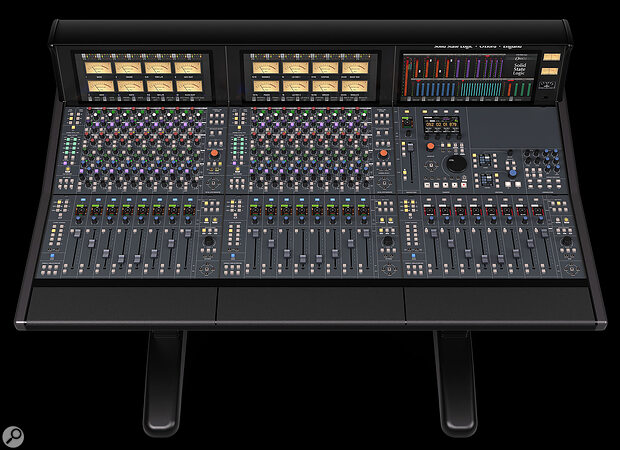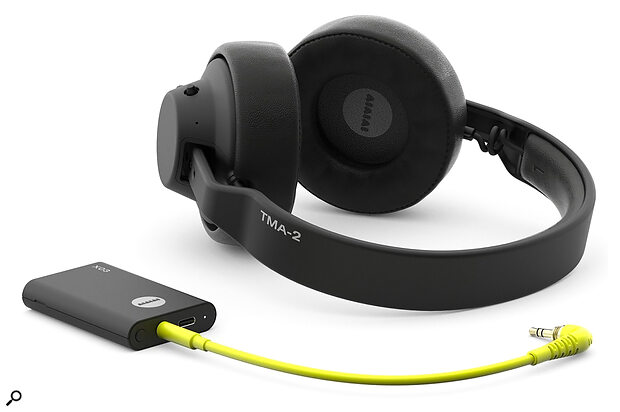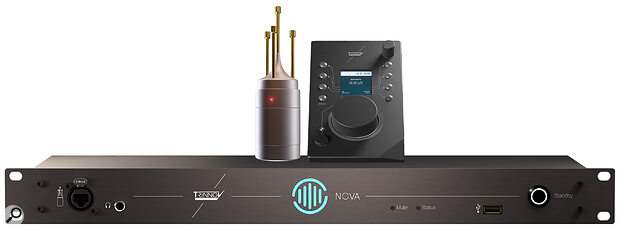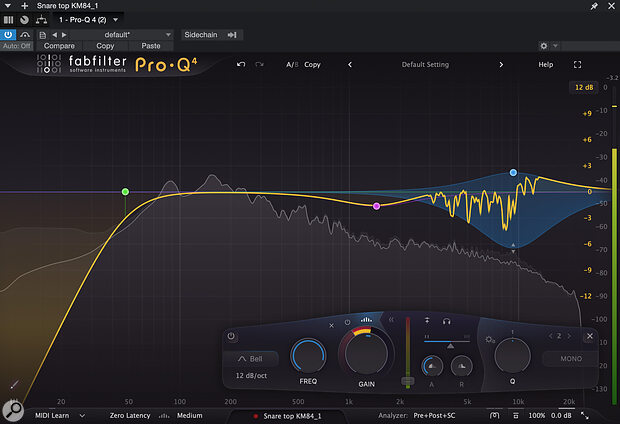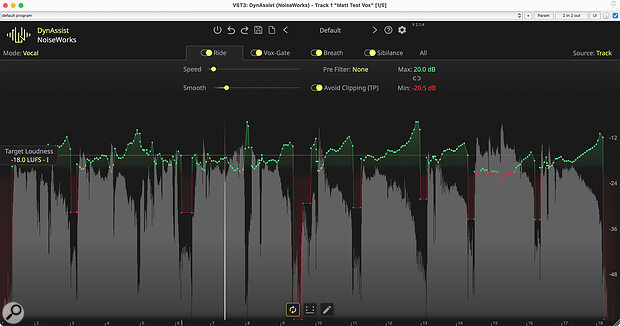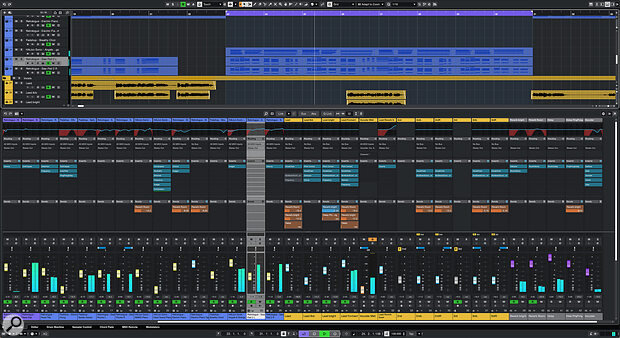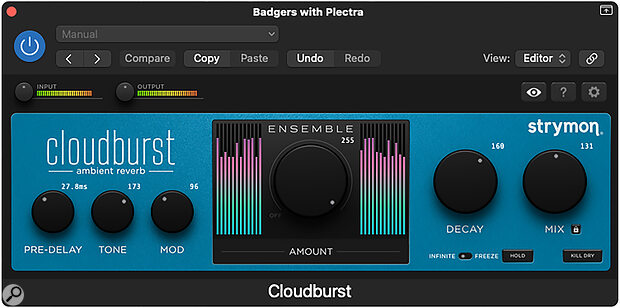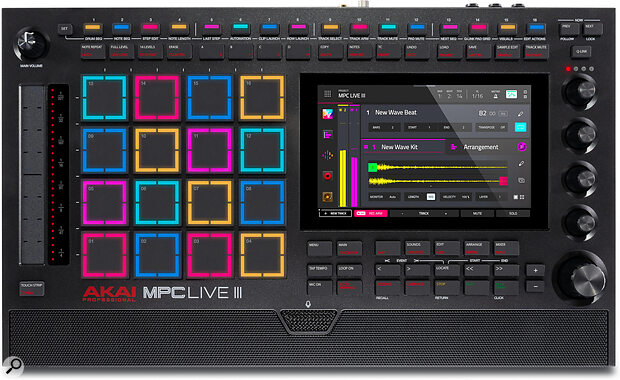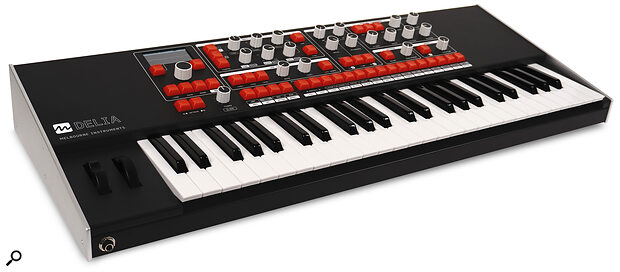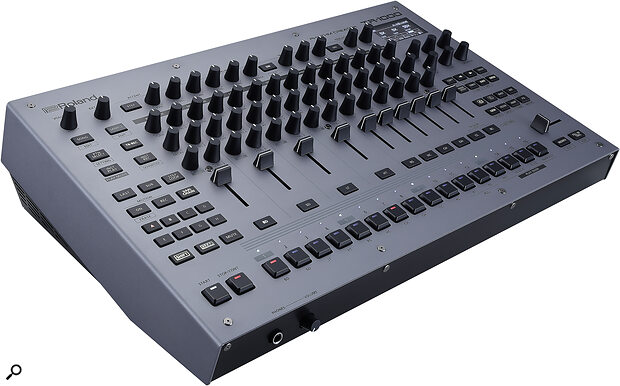- Audio Interfaces
- DAW Software
- Guitar Technology
- Microphones / Miking
- Monitors / Monitoring
- Preamps / Channel Strips
- Signal Processors
- Synthesizers
The SOS team pick their highlights from hardware and software launches from 2025.
Studio Hardware
AEA 1029
At first glance I thought that the AEA 1029’s compression options might be slightly limited. However, once I’d explored the extent of its capabilities, the 1029 proved to be an impressive performer. It is more than capable of delivering superb, open and transparent audio performance and impressively precise control of peaks across a wide range of sources. The fixed attack and release timings have been very carefully chosen, which made working with the 1029 a hugely enjoyable and intuitive exploration of its possibilities. Overall, the AEA 1029 is a compressor that gets the job done and is, for my needs, the ideal companion for recording with stereo microphone setups. Bob Thomas
aearibbonmics.com/aea-products/1029
Atomic Analog Tonograf EQ
 Atomic Analog TonografThe Tonograf EQ by Atomic Analog is a part‑for‑part recreation of the legendary TAB W95 equaliser module from the early 1960s — a fast‑moving period in audio design that saw the original designer take the ideas used in earlier tube devices such as the V72 and V76 amplifiers and adapt them to low‑voltage transistor circuitry. With simple high and low shelving filters and an inductive mid‑band option, these units have a pleasing inherent sound combined with a simple‑to‑use EQ that works superbly for all‑round recording and mixing. It took a huge amount of financial discipline to take them out of my rack and send them back after the review period! These classy‑looking EQs definitely sit in the more luxury end of the market price‑wise, but pack an awful lot of analogue muscle into a 500‑series module. Neil Rogers
Atomic Analog TonografThe Tonograf EQ by Atomic Analog is a part‑for‑part recreation of the legendary TAB W95 equaliser module from the early 1960s — a fast‑moving period in audio design that saw the original designer take the ideas used in earlier tube devices such as the V72 and V76 amplifiers and adapt them to low‑voltage transistor circuitry. With simple high and low shelving filters and an inductive mid‑band option, these units have a pleasing inherent sound combined with a simple‑to‑use EQ that works superbly for all‑round recording and mixing. It took a huge amount of financial discipline to take them out of my rack and send them back after the review period! These classy‑looking EQs definitely sit in the more luxury end of the market price‑wise, but pack an awful lot of analogue muscle into a 500‑series module. Neil Rogers
Cranborne Audio Brick Lane 500
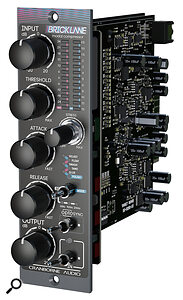 Cranborne Audio Brick Lane 500Although notoriously difficult to engineer well and historically expensive to implement, PWM technology has long been the ‘holy grail’ of analogue compression, offering the very best technical performance and widest range of artistic control. So Cranborne Audio are to be applauded for delivering a brilliantly well‑designed and incredibly versatile PWM compressor, genuinely pushing the envelope of what a compressor can achieve — and at an impressively affordable price, too. The Brick Lane 500 has been the most inspiring product of 2025 for me, without a doubt. Hugh Robjohns
Cranborne Audio Brick Lane 500Although notoriously difficult to engineer well and historically expensive to implement, PWM technology has long been the ‘holy grail’ of analogue compression, offering the very best technical performance and widest range of artistic control. So Cranborne Audio are to be applauded for delivering a brilliantly well‑designed and incredibly versatile PWM compressor, genuinely pushing the envelope of what a compressor can achieve — and at an impressively affordable price, too. The Brick Lane 500 has been the most inspiring product of 2025 for me, without a doubt. Hugh Robjohns
Freqport FreqInOut FO1
Several tools for seamlessly integrating analogue processing into a DAW environment have appeared in recent years, and Freqport’s FreqInOut FO1 is one of the neatest I’ve come across. To your computer, it’s a USB interface with line‑level I/O that can be used to loop in outboard. But to the user, it’s a real‑time plug‑in that can be stored and recalled with DAW sessions. Sam Inglis
Garbage Ideas FK Comp
 Garbage Ideas FK CompGarbage Ideas’ debut, the FK Comp, was one of the products I most enjoyed playing with in the last year. A relatively affordable, simple‑to‑use FET compressor, the FK Comp employs a non‑linear amplifier stage that encourages you to lean into the more characterful side of compression. With simple input, output and mix controls and an LED light that proudly proclaims “You did it!” when the compression threshold is breached, you probably get the idea that this isn’t a tool for audiobook recordings — although it is capable of clean level control if used carefully. I loved it for driving drums or vocals into that heavy saturated compression sound, which — thanks to the blend control and the clever design of the circuit — still manages to retain enough clarity to be usable come mix time. Neil Rogers
Garbage Ideas FK CompGarbage Ideas’ debut, the FK Comp, was one of the products I most enjoyed playing with in the last year. A relatively affordable, simple‑to‑use FET compressor, the FK Comp employs a non‑linear amplifier stage that encourages you to lean into the more characterful side of compression. With simple input, output and mix controls and an LED light that proudly proclaims “You did it!” when the compression threshold is breached, you probably get the idea that this isn’t a tool for audiobook recordings — although it is capable of clean level control if used carefully. I loved it for driving drums or vocals into that heavy saturated compression sound, which — thanks to the blend control and the clever design of the circuit — still manages to retain enough clarity to be usable come mix time. Neil Rogers
Hazelrigg Industries DNE
 Hazelrigg Industries DNEThe Hazelrigg DNE is a superb compressor that had me reaching for my wallet almost as I switched it on. Its pulse width‑modulated, twin side‑chain circuits come directly from DW Fearn’s stellar VT7 PWM compressor. Each side‑chain has its own attack and release time constants, which are blended together to control the DNE’s pulse width‑modulated gain cell, allowing the compression to be tailored to deliver subtle control of the dynamics of vocals, acoustic guitar, double bass, piano and percussion instruments. Even when larger amounts of gain reduction are needed, the DNE’s low ratio, soft‑knee style of compression remains incredibly transparent. The Hazelrigg DNE is one of, if not the, finest 500‑series compressor that I’ve had the pleasure of reviewing. I still miss it, and my wallet still worries about that. Bob Thomas
Hazelrigg Industries DNEThe Hazelrigg DNE is a superb compressor that had me reaching for my wallet almost as I switched it on. Its pulse width‑modulated, twin side‑chain circuits come directly from DW Fearn’s stellar VT7 PWM compressor. Each side‑chain has its own attack and release time constants, which are blended together to control the DNE’s pulse width‑modulated gain cell, allowing the compression to be tailored to deliver subtle control of the dynamics of vocals, acoustic guitar, double bass, piano and percussion instruments. Even when larger amounts of gain reduction are needed, the DNE’s low ratio, soft‑knee style of compression remains incredibly transparent. The Hazelrigg DNE is one of, if not the, finest 500‑series compressor that I’ve had the pleasure of reviewing. I still miss it, and my wallet still worries about that. Bob Thomas
Neve 88C
The Neve 88C compact dual‑channel VCA compressor borrows heavily from the 88RS console’s channel dynamics, including clever features such as the adaptive attack. It’s all powered over USB‑C and this, along with the rugged leatherette chassis, makes it way more portable than most analogue compressors. And Neve have made great use of the front‑panel real estate too, with dual‑purpose controls, channel linking options, and meters changing colour to denote different modes, amongst other things. Most importantly of all, it’s really easy to dial in and, to my ears, sounds smooth and natural on pretty much any source. Matt Houghton
SSL Oracle
While the SSL Oracle wasn’t quite the most expensive new mixing console that I laid hands and eyes on this year, it’s very definitely aimed at the high‑end professional market. And while that sort of money can buy other analogue consoles with recall systems and digital control, there’s nothing else that delivers the concept so completely: it’s an SSL console with an entirely analogue signal path, but whose every setting can be recalled accurately in less time than it takes to boot your DAW. There’s an EQ on every channel that can be set to SSL’s E or G‑series ‘flavour’ and the ability to set up sessions remotely. Best of all, to my mind, is that, unlike typical digital mixers, it can offer almost the same ‘one‑knob‑per‑parameter’ immediacy as a traditional analogue console if you want that. Oh, and it sounds great too! Matt Houghton
Tascam Studio Bridge
Sometimes, I don’t like screens — they encourage me to use my eyes before my ears — and the Tascam Studio Bridge has let me escape them; it’s made it practical to put my mixing console back at the heart of recording and jamming sessions. It’s the first 24‑track recorder for decades that lets you individually arm its 24 tracks, and record overdubs and punch‑ins. I can load backing tracks, sketch out a song structure in advance and, when I’m done, transfer the WAV files to my DAW. Oh, and it doubles up as about the best value USB audio interface with 24 line‑level analogue I/O there is! Matt Houghton
Monitoring
ADAM Audio D3V
Before I’d reviewed ADAM Audio’s compact D3V monitors, I would never have considered installing a pair of dedicated active computer loudspeakers costing almost £300 on my desktop. However, once I’d heard the results of connecting my computer over USB‑C to the D3V’s 200W RMS of stereo amplification via its onboard DAC, the ultimate decision was never in doubt. The combination of that amplifier power with the D3V’s all‑new D‑ART ribbon tweeter, 3.5‑inch woofers, and twin 3.5‑inch passive radiators, delivers a superbly detailed overall performance. Thanks to its passive radiators, the power and accuracy of the D3V’s low‑frequency extension and delivery belies its compact dimensions, while its wallet‑friendly price point only adds to its attraction. Bob Thomas
AIAIAI TMA-2 Studio Wireless
I’m perfectly used to using wireless headphones for gaming and other media, but it was still a strange experience to walk around untethered while listening to my DAW on AIAIAI’s TMA‑2 Studio Wireless cans. This latest iteration of their wireless studio headphone technology, while not lossless like the earlier Wireless+ model, is still easily good enough in quality for most studio purposes (if not mastering), and the latency is considerably lower (certainly low enough for tracking virtual instruments). They’re perfect for that ‘pacing around restlessly’ stage of production, and they’re also, like all of AIAIAI’s products, commendably eco‑conscious in terms of manufacture and repairability. Chris Korff
Amphion One18x
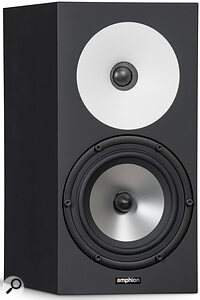 Amphion One18XOne of the reasons I still find monitors so fascinating is that speaker engineers continue to find so many different ways of skinning the cat. There’s the contemporary, high‑tech DSP route and there’s the more traditional analogue artisanal route — and countless options in between. And even if a manufacturer takes the traditional analogue route, there’s always improvements and more performance to be found. I reviewed the original Amphion One18 a decade ago, and even though the 2025 One18X version appears to be very similar, the reality is that it seems to have taken quite a significant step up in performance. The One18X demonstrates strong correlation between serious, engineering‑based electro‑acoustic development and subjective performance. The reduced distortion of the new tweeter seems genuinely audible and has lifted the performance of the entire system. The One18X was a genuine pleasure to have for a while in the studio. Phil Ward
Amphion One18XOne of the reasons I still find monitors so fascinating is that speaker engineers continue to find so many different ways of skinning the cat. There’s the contemporary, high‑tech DSP route and there’s the more traditional analogue artisanal route — and countless options in between. And even if a manufacturer takes the traditional analogue route, there’s always improvements and more performance to be found. I reviewed the original Amphion One18 a decade ago, and even though the 2025 One18X version appears to be very similar, the reality is that it seems to have taken quite a significant step up in performance. The One18X demonstrates strong correlation between serious, engineering‑based electro‑acoustic development and subjective performance. The reduced distortion of the new tweeter seems genuinely audible and has lifted the performance of the entire system. The One18X was a genuine pleasure to have for a while in the studio. Phil Ward
Trinnov Nova
Room and monitor optimisation systems are not without issues. The primary challenges are the distortion of nearfield monitor frequency response in the interests of ‘flat’ in‑room response, and the general lack of any skin in the time‑domain game. The Trinnov system has for some time
been probably the most effective in terms of managing and minimising the inherent issues, but until its Nova system came along, the entry price was high and the user interface was idiosyncratic at best. Trinnov’s Nova changed all that. It brought the price down from eye‑watering to potentially affordable, and it offers an interface that’s easily usable by mere mortals. Of all the review subjects that had temporary studio residence in 2025, Trinnov’s Nova is probably the one I’d most wish didn’t have to leave. Phil Ward
Microphones
Braingasm Ocula
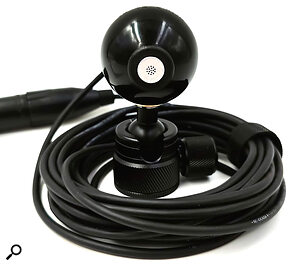 Braingasm OculaIn the world of classical recording, Acoustic Pressure Equalisation (APE) of small‑diaphragm omnidirectional capsules has long been a very desirable thing — ever since Neumann introduced the M50 in 1951, in fact — enhancing the HF directivity to improve stereo imaging in spaced mic arrays like the Decca Tree. Many SDC omni microphone manufacturers offer accessory APEs to fit their mics, but Braingasm’s Ocula is the only model (other than M50 tributes) to feature a permanently integrated APE, which makes it very special indeed. It also happens to be quite attractively priced in comparison to the alternatives, making it a very desirable option for classical recording aficionados. Hugh Robjohns
Braingasm OculaIn the world of classical recording, Acoustic Pressure Equalisation (APE) of small‑diaphragm omnidirectional capsules has long been a very desirable thing — ever since Neumann introduced the M50 in 1951, in fact — enhancing the HF directivity to improve stereo imaging in spaced mic arrays like the Decca Tree. Many SDC omni microphone manufacturers offer accessory APEs to fit their mics, but Braingasm’s Ocula is the only model (other than M50 tributes) to feature a permanently integrated APE, which makes it very special indeed. It also happens to be quite attractively priced in comparison to the alternatives, making it a very desirable option for classical recording aficionados. Hugh Robjohns
Lauten Audio LT-386 Eden
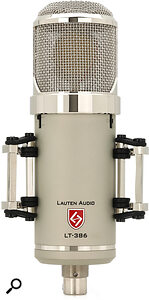 Lauten Audio LT‑386 EdenThe Lauten LT‑386 Eden valve microphone was a real feature item in my studio during the month or so I had it for review this Summer, sitting almost permanently in position, ready for the next vocalist, guitarist or drummer to cross its path. This is not a cheap mic by any means, but it does offer a surprising amount of versatility thanks to some clever ‘multi‑voice’ circuitry that changes the mic’s signal path. The Neutral setting offers a clean U47‑style sound, or you can go a bit darker and more obviously coloured with the Gentle setting. Most striking, though, is the Forward option, which puts you clearly in Sony C‑800G territory with a bright, modern vocal sound. There is also a two‑stage high‑pass filter that adds even more flavour control to this substantial valve mic. One for the fantasy wish list, perhaps, due to the pricing, but well worth checking out if you’re in the market for one special mic to do a lot of jobs well. Neil Rogers
Lauten Audio LT‑386 EdenThe Lauten LT‑386 Eden valve microphone was a real feature item in my studio during the month or so I had it for review this Summer, sitting almost permanently in position, ready for the next vocalist, guitarist or drummer to cross its path. This is not a cheap mic by any means, but it does offer a surprising amount of versatility thanks to some clever ‘multi‑voice’ circuitry that changes the mic’s signal path. The Neutral setting offers a clean U47‑style sound, or you can go a bit darker and more obviously coloured with the Gentle setting. Most striking, though, is the Forward option, which puts you clearly in Sony C‑800G territory with a bright, modern vocal sound. There is also a two‑stage high‑pass filter that adds even more flavour control to this substantial valve mic. One for the fantasy wish list, perhaps, due to the pricing, but well worth checking out if you’re in the market for one special mic to do a lot of jobs well. Neil Rogers
Warm Audio WA-CX24
 Nordic Audio Labs NU‑24KIt’s been a good year for studio microphones, and most of those I’ve tried have had some outstanding qualities. I was impressed by the scale and ambition of Warm Audio’s WA‑CX24, the ergonomic innovation of Aim Audio’s Inspire, the versatility of Audix’s D6X, the honesty of the Royer R12 and AEA N28, and the understated class of the Austrian Audio OC‑S10. But the microphone that tested my self‑restraint most of all was the Nordic Audio Labs NU‑24K. It looks stunning and sounds even better, and it will be a long time before my credit card is safe around it! Sam Inglis
Nordic Audio Labs NU‑24KIt’s been a good year for studio microphones, and most of those I’ve tried have had some outstanding qualities. I was impressed by the scale and ambition of Warm Audio’s WA‑CX24, the ergonomic innovation of Aim Audio’s Inspire, the versatility of Audix’s D6X, the honesty of the Royer R12 and AEA N28, and the understated class of the Austrian Audio OC‑S10. But the microphone that tested my self‑restraint most of all was the Nordic Audio Labs NU‑24K. It looks stunning and sounds even better, and it will be a long time before my credit card is safe around it! Sam Inglis
Sound Devices Astral
Wireless radio mic systems are ubiquitous these days, but Sound Devices really pushed the technological boundaries with their incredibly flexible Astral range, which goes far beyond any other current system’s capabilities. For example, 16 digital receivers housed in a 1U half‑rack unit is mind‑blowing enough, but the abiity to tune them anywhere between 169MHz and 1.8GHz, while providing balanced analogue, AES3 and Dante outputs, had me gobsmacked! The associated transmitter units are just as impressively versatile and fabulously well‑engineered. The Astral range is not just at the peak of digital wireless technology; it’s hovering far above it! Hugh Robjohns
Audio Interfaces & Converters
Apogee Symphony Studio
The Apogee Symphony Studio range of USB interfaces reflects the apparently unstoppable trend towards mixing in immersive formats by offering generous output channel numbers and high‑end monitor control via a comprehensively specified app. But simultaneously with offering all that, the Symphony Studio range doesn’t forget the tracking functions of an interface, so its mic inputs are very highly specified, all but noiseless, and sound really great. Being a USB interface that has both high‑end tracking and immersive mixing fully covered makes the Symphony Studio range something of an outlier, and a natural pick for Gear Of The Year. Phil Ward
PreSonus Quantum HD8
Having been a big fan of the original Thunderbolt‑based PreSonus Quantum, I was sceptical about the reinvention of the range as a series of USB interfaces. Would that not lose what made the originals special? I need not have worried. The PreSonus Quantum HD8 and its siblings not only offer remarkable audio specs for the money, plus welcome bonus features such as auto‑gain and re‑amp outputs; they also offer seriously good low‑latency performance, at a very competitive price. Sam Inglis
RME ADI‑2/4Pro SE
RME’s ADI range of specialist interface/converters have always delivered impressive class‑leading performance, and when the company releases a new model that raises the bar even further it’s impossible not to admire their expertise and devotion. The ADI‑2/4Pro SE’s dynamic range performance is the best I’ve ever measured, and the D‑A side improves significantly on its predecessor, too, which is just extraordinary. Digital RIAA equalisation has been added for vinyl enthusiasts, as well as impressive balanced headphone driving capability and a more versatile I/O structure. This is a superbly engineered product. Hugh Robjohns
SSL Alpha 8
Solid State Logic have been cranking out new products at such a rate this year that it’s been hard to keep up. There have been two superb channel strips, plus the excellent 18 USB audio interface and the mighty Oracle console, among others. But the one that has really hit the mark for me is the Alpha 8. A line‑level ADAT expander might not seem like the most exciting product — but this is so much more than a conventional line‑level ADAT expander. Sam Inglis
Software
APL Virtuoso 2
 APL Virtuoso 2You need a room full of monitors, mounting hardware and cables to mix in Dolby Atmos, right? Well, no, not if you have APL Virtuoso 2. Virtuoso 2 is a multi‑channel room and monitor modelling app that takes the output from, for example, the Dolby Atmos renderer, and plays it over headphones such that you can be effectively ‘fooled’ into hearing multiple monitors in a room. Not many Sound On Sound review subjects make me laugh out loud but Virtuoso 2 did. It’s not dissimilar to the feeling when a good magician performs close magic. Your inability to process what just happened leaves you laughing. I’d listen to an Atmos mix conventionally, then put headphones on with the room and monitors modelled in Virtuoso 2, and the sound would be really pretty similar, and it would make me laugh. Many more times than once I took the headphones off to check the monitors were muted. Virtuoso 2 is truly uncanny. Phil Ward
APL Virtuoso 2You need a room full of monitors, mounting hardware and cables to mix in Dolby Atmos, right? Well, no, not if you have APL Virtuoso 2. Virtuoso 2 is a multi‑channel room and monitor modelling app that takes the output from, for example, the Dolby Atmos renderer, and plays it over headphones such that you can be effectively ‘fooled’ into hearing multiple monitors in a room. Not many Sound On Sound review subjects make me laugh out loud but Virtuoso 2 did. It’s not dissimilar to the feeling when a good magician performs close magic. Your inability to process what just happened leaves you laughing. I’d listen to an Atmos mix conventionally, then put headphones on with the room and monitors modelled in Virtuoso 2, and the sound would be really pretty similar, and it would make me laugh. Many more times than once I took the headphones off to check the monitors were muted. Virtuoso 2 is truly uncanny. Phil Ward
Fabfilter Pro-Q 4
I’ve been a fan of FabFilter’s plug‑ins since they released their Mastering Bundle 15 years ago. Since then, they’ve rarely put a foot wrong, but this year’s Pro‑Q 4 equaliser plug‑in is a real highlight. It retains all the good qualities of previous iterations, and adds goodies like resonance suppression and the ability to edit multiple instances from a single plug‑in window. I’ve barely opened another EQ plug‑in since I installed it. Sam Inglis
Noiseworks DynAssist
A real time‑saver, Noiseworks DynAssist can make sure every syllable is heard clearly, and every breath and ess is near the optimum level. For something that, when you boil it down to its bare essentials, simply turns your audio up and down, it’s an incredible piece of software. It has already changed the way I approach editing and processing dialogue, and a little bird tells me there’ll soon be some impressive new strings to its bow! Matt Houghton
Steinberg Cubase 14 Pro
I’m lucky enough to have experienced most of the major DAW platforms over the last 20‑plus years, and have reviewed a number of them for SOS. There are some amazing options available, but Steinberg's Cubase has been my personal DAW‑of‑choice for all of that time. Amongst a range of refinements to an already impressive specification, Cubase 14 Pro added a brilliant Drum Machine instrument, a cool new Pattern Editor environment and the very powerful Modulator system. My personal ‘best’ just keeps bettering better. John Walden
Strymon Cloudburst
Strymon’s Cloudburst pedal is still unique amongst reverb effects, going beyond ‘shimmer’ to a type of reverb tail resynthesis that makes the reverb sound almost like an orchestral layer. Cloudburst Plug‑in brings that sound straight to your DAW, making editing easier and of course allowing you to use the effect on multiple tracks if required. Having the reverb enhancement on a continuously variable control rather than two switch positions is really useful, as are the freeze functions. While Cloudburst might seem to be aimed at ambient composers, where it is of course extremely welcome, it can also fit into many other musical genres too. Paul White
Hardware Instruments
AKAI MPC Live III
Having already pulled ahead as the most functional production workstation on the market with version 3 of the MPC OS, Akai followed up with a mic‑drop of a launch in the MPC Live MkIII. With four times the processing power, even more expandability, mic pres and a built‑in mic, the new Live is finally a true one‑stop portable production system. It’s also been upgraded as an instrument, looking to widen its appeal with step sequencing and clip matrix workflows, and introducing an innovative, expressive pad grid. Simon Sherbourne
Cutlasses Gloop
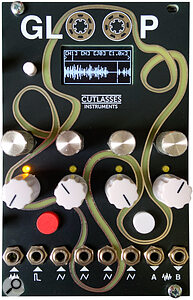 Cutlasses GloopWhat makes a good Eurorack module? Originality? Usefulness? Ease of use? Cutlasses Instruments’ Gloop combines all three. The idea of a tape‑style looper but with four playback heads instead of one is certainly original, and it’s definitely useful... Wondering what to do with your carefully crafted eight‑step sequence? Gloop can reorder it on the fly, turn it into a half‑speed version, do Steve Reich‑style phasing, make it into a textural drone or a lovely twinkly ambient piece — and probably lots of other things I haven’t thought of yet. It’s also intuitive, blessed with a decent reverb and delay that can affect passing as well as recorded signals, and rejoices in one of the best digital implementations of Frippertronics I’ve come across. Gloop is very much the gift that keeps on giving, and in my opinion is a very good Eurorack module. David Glasper
Cutlasses GloopWhat makes a good Eurorack module? Originality? Usefulness? Ease of use? Cutlasses Instruments’ Gloop combines all three. The idea of a tape‑style looper but with four playback heads instead of one is certainly original, and it’s definitely useful... Wondering what to do with your carefully crafted eight‑step sequence? Gloop can reorder it on the fly, turn it into a half‑speed version, do Steve Reich‑style phasing, make it into a textural drone or a lovely twinkly ambient piece — and probably lots of other things I haven’t thought of yet. It’s also intuitive, blessed with a decent reverb and delay that can affect passing as well as recorded signals, and rejoices in one of the best digital implementations of Frippertronics I’ve come across. Gloop is very much the gift that keeps on giving, and in my opinion is a very good Eurorack module. David Glasper
Melbourne Instruments Delia
The follow up to Melbourne Instruments’ impressive Nina debut, the Delia is a six‑voice polysynth boasting a 49‑note keyboard and of course Melbourne’s signature motorised knobs. These don’t just allow the physical panel controls to snap to correct values when loading a preset; they can take on steps or detents and move by themselves to take care of certain types of automation. The Delia is armed with fantastic‑sounding DCOs, dedicated high‑pass and low‑pass filters, onboard effects and a slew of other functions, including the brilliant Morph, which gives each preset two interpolated layers that can be ‘faded’ between, with its motorised knobs moving in real time. William Stokes
Roland TR-1000
Ending decades of speculation about whether Roland were done with analogue, the OGs are back with a flagship, best‑of‑both‑worlds drum machine that puts the transistor back in Transistor Rhythm. Most of the original 808 and 909 synth circuits are on board, side‑by‑side with ACB digital, FM, PCM and sampling. Built around the ultra‑performable TR‑8/8S mixer‑style design, but with greatly improved usability, and incorporating modern performance and sequencing workflows influenced by newer‑generation instruments, the TR‑1000 is the best drum machine Roland have ever made. Simon Sherbourne
Sequential Fourm
At first glance, Sequential’s latest synthesizer offers nothing new. The Fourm is a two‑oscillator, four‑voice analogue synth with mini‑keys. Big deal. But this little powerhouse turns out to be all sweet spot, with a sumptuous vintage sound at a reasonable price. It’s a masterclass in miniaturising, somehow managing to retain a big synth analogue sound and user experience. Think of it as a monosynth with four voices, surprisingly playable polyphonic aftertouch, a one‑knob‑per‑function front panel and plenty of thoughtful modernisations. It also proves that Sequential is in great hands under the stewardship of Focusrite. Rory Dow
Virtual Instruments
Arturia V Collection 11
Following the rich pickings of new hardware synths and keyboards over the past few years, 2025 has — for an old progger like me — been a bit of a fallow year. But I continue to be impressed by the ongoing advances in soft‑synth technology. There are numerous low‑cost but high‑quality offerings from the likes of Cherry Audio, but the standout for me was Arturia’s latest V Collection. The company keep adding high‑quality synths (innovative as well as imitative) and V Collection 11 is now so wide‑ranging that I doubt that anyone will ever fully plumb its depths. I just wonder when they’re going to add all of the other instruments that I’ve requested. Gordon Reid
Dreamtonics Synthesizer V Studio 2 Pro
Since I first used it back in 2023, Synthesizer V by Dreamtonics has regularly left my mouth contorted between my jaw hitting the floor and a smile so big my face might split. The option to use a virtual instrument that can deliver the melody, lyrics and expression of a very respectable human session singer is a bit of a songwriter’s dream. The arrival of v2 didn’t change that one bit, it just refined the software’s operation and added some additional functionality. Synth V is a truly remarkable piece of technology. John Walden
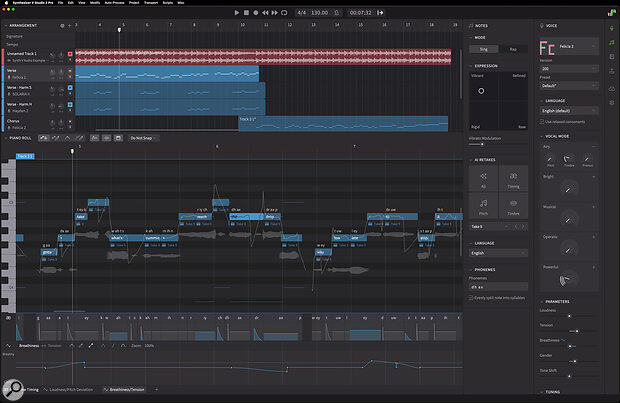 Dreamtonics Synthesizer V Studio 2 Pro
Dreamtonics Synthesizer V Studio 2 Pro
Song Athletics Bones
 Song Athletics BonesBeautifully recorded, versatile, easy‑to‑use samples in the form of loops and one‑shots – there’s a lot to love about Bones, the sample pack containing over 1000 royalty‑free sounds by British creative studio Song Athletics. When I first heard it, I felt like I’d been sent tracks by a well‑curated group of talented performers and recordists with a seriously good ear for tone. You can keep it simple by layering drum loops, melodic lines, and vocal samples, or get properly experimental with modulation effects, distortion, reversing, chopping, time stretching — the studio‑quality recordings are a treat to work with. While this is a general‑use sample pack containing the basic building blocks needed for a piece of music, there’s nothing generic about the sounds and I must say, I’ve thoroughly enjoyed exploring the collection over the past few months. Sonal D’Silva
Song Athletics BonesBeautifully recorded, versatile, easy‑to‑use samples in the form of loops and one‑shots – there’s a lot to love about Bones, the sample pack containing over 1000 royalty‑free sounds by British creative studio Song Athletics. When I first heard it, I felt like I’d been sent tracks by a well‑curated group of talented performers and recordists with a seriously good ear for tone. You can keep it simple by layering drum loops, melodic lines, and vocal samples, or get properly experimental with modulation effects, distortion, reversing, chopping, time stretching — the studio‑quality recordings are a treat to work with. While this is a general‑use sample pack containing the basic building blocks needed for a piece of music, there’s nothing generic about the sounds and I must say, I’ve thoroughly enjoyed exploring the collection over the past few months. Sonal D’Silva
Spitfire Audio BBC Radiophonic Workshop
Spitfire Audio’s BBC Radiophonic Workshop library celebrates a cherished national institution. Drawing upon a vast tape archive collated by Mark Ayres, this fascinating collection takes a Tardis‑like journey through 40 years of musical ingenuity, bringing together experimental 1950s electronica, otherworldly soundscapes, sci‑fi effects, early analogue synths, historic instruments, ‘found sounds’ performed by original RW members at Maida Vale Studios, junk percussion, tape loops and new processed ‘warp’ treatments. Also included is a brilliant recreation of Delia Derbyshire’s iconic, swooping oscillator‑driven ‘ooh‑wee‑ooh’ lead sound heard in the Doctor Who theme, an essential patch for all keyboardists! Dave Stewart
 Spitfire Audio BBC Radiophonic Workshop
Spitfire Audio BBC Radiophonic Workshop
Sub51 Drop Pad 3
I was a fan of the original Sub51 Drop Pad for Kontakt, but it has now been updated to run also on the free Kontakt Player, as well as adopting a number of new performance features. It also has a completely new sound library, though owners of older Drop Pad versions can still use their original samples alongside the new ones to create new patches. Drop Pad isn’t the only instrument to allow four sample sources to be dynamically blended, but the ability to add movement also extends to the effects. Its rhythmic patches, which can be built up from layers, always remain in sync and can be locked to any DAW tempo. Despite its flexibility, Drop Pad 3 remains intuitive in use and is capable of generating sounds that span all genres from ambient to gritty EDM. Paul White
Guitar Technology
Electro‑Harmonix Oceans Abyss
The Electro‑Harmonix Oceans Abyss can run two types of reverb, along with a range of other effects blocks that can be configured in a number of series and parallel configurations, all aided by a display showing the connections in graphical form. There are delays, filters, modulators and more to play with, making Oceans Abyss something of a multi‑effects workstation. It is fairly intuitive to use but digging deep can take time, which is where the upcoming software editor will come in very handy. If you like exploring complex delay and reverb effects, you’ll find a lot to like in Oceans Abyss. Paul White
www.ehx.com/products/oceans-abyss
Origin Effects Deluxe55
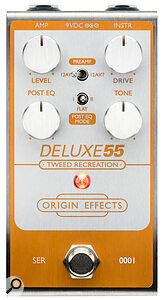 Origin Effects Deluxe55The great thing about a ‘Tweed‑era’ Fender Deluxe amp is that it sounds almost instantly ‘right’ for a whole lot of the classic electric guitar sound ‘vocabulary’ the moment you plug into it. Which is good, because there’s very little on the amp for you to tweak: the Tone control really only has a couple of sensible settings, and you might want to get fancy by dialling in a little interaction between the channels, but apart from that, you just set the Volume low if you want the beautiful, rich cleans, or turn it up for the uniquely gnarly distortion it offers. Origin Effects’ Deluxe55 pedal version makes it even simpler by omitting the second channel from their incredibly authentic‑sounding, all‑analogue recreation of this classic tube amp, which uses solid‑state components to replicate every part of the original circuitry. You can run it into an amp, but I think it does its best work paired with a really good IR or speaker modeller, where it can give you the instant gratification of a miked‑up Tweed Deluxe in a DI recording. Yes, it will ‘flub’ like mad under full distortion if you are not careful, just like the real thing, but that’s just part of the beauty of this amp — it puts so much range of expression into the hands of the player and the choice of pickup and volume control settings. I’ve simply never heard a better emulation. Dave Lockwood
Origin Effects Deluxe55The great thing about a ‘Tweed‑era’ Fender Deluxe amp is that it sounds almost instantly ‘right’ for a whole lot of the classic electric guitar sound ‘vocabulary’ the moment you plug into it. Which is good, because there’s very little on the amp for you to tweak: the Tone control really only has a couple of sensible settings, and you might want to get fancy by dialling in a little interaction between the channels, but apart from that, you just set the Volume low if you want the beautiful, rich cleans, or turn it up for the uniquely gnarly distortion it offers. Origin Effects’ Deluxe55 pedal version makes it even simpler by omitting the second channel from their incredibly authentic‑sounding, all‑analogue recreation of this classic tube amp, which uses solid‑state components to replicate every part of the original circuitry. You can run it into an amp, but I think it does its best work paired with a really good IR or speaker modeller, where it can give you the instant gratification of a miked‑up Tweed Deluxe in a DI recording. Yes, it will ‘flub’ like mad under full distortion if you are not careful, just like the real thing, but that’s just part of the beauty of this amp — it puts so much range of expression into the hands of the player and the choice of pickup and volume control settings. I’ve simply never heard a better emulation. Dave Lockwood
Red Panda Radius
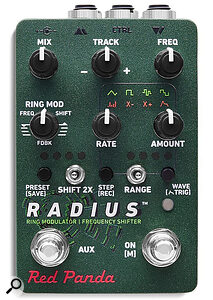 Red Panda RadiusI often struggle to find musical applications for ring modulators, but the Red Panda Radius pedal adds features that really help push the boundaries of what the effect can achieve. With the ability to blend ring modulation with frequency shifting, a flexible modulation section that includes an envelope follower and the ability to have the modulation oscillator track the incoming audio pitch (monophonic), the results go from classic inharmonic ring modulation to bell‑like timbres, drones, harmonic enrichment and even slow, dreamy modulation. If, like me, you had written off ring modulation as too unmusical, this pedal might get you to reconsider, and I suspect the modular synth fraternity will really love it. Paul White
Red Panda RadiusI often struggle to find musical applications for ring modulators, but the Red Panda Radius pedal adds features that really help push the boundaries of what the effect can achieve. With the ability to blend ring modulation with frequency shifting, a flexible modulation section that includes an envelope follower and the ability to have the modulation oscillator track the incoming audio pitch (monophonic), the results go from classic inharmonic ring modulation to bell‑like timbres, drones, harmonic enrichment and even slow, dreamy modulation. If, like me, you had written off ring modulation as too unmusical, this pedal might get you to reconsider, and I suspect the modular synth fraternity will really love it. Paul White
www.redpandalab.com/products/radius
Source Audio Encounter
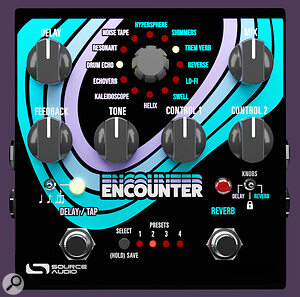 Source Audio EncounterBased on the same hardware as the Collider pedal but running different code, Source Audio’s Encounter is a dual‑channel pedal aimed at the production of cinematic and ambient reverbs and delays. The user can combine a delay and reverb or two of each type of effects, where the many options include filtering, modulation, pitch shifting and reverb reverb. I had so much fun reviewing this pedal that Source Audio said they’d like to use some of the presets I’d created. If you like the transformative abilities of granular processing but crave something smoother, then Encounter is most definitely a pedal to try. Interestingly, their on‑line editor includes a virtual model of the pedal so you can create or edit presets even without a pedal connected. Paul White
Source Audio EncounterBased on the same hardware as the Collider pedal but running different code, Source Audio’s Encounter is a dual‑channel pedal aimed at the production of cinematic and ambient reverbs and delays. The user can combine a delay and reverb or two of each type of effects, where the many options include filtering, modulation, pitch shifting and reverb reverb. I had so much fun reviewing this pedal that Source Audio said they’d like to use some of the presets I’d created. If you like the transformative abilities of granular processing but crave something smoother, then Encounter is most definitely a pedal to try. Interestingly, their on‑line editor includes a virtual model of the pedal so you can create or edit presets even without a pedal connected. Paul White
Universal Audio UAFX Enigmatic '82
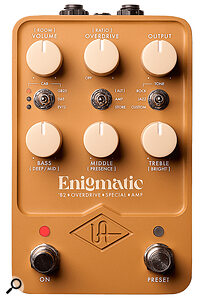 Universal Audio UAFX Enigmatic ’82It’s no secret that I’m a big fan of Universal Audio’s amp emulation pedals — all of them! Even as a diehard lover of classic tube amps, I have to say that I often now use a DI’ed UA pedal for recording in preference to the ‘real thing’. Sometimes it’s just quicker and easier than rigging a mic, or firing up the OX, with no loss of tone or feel that I can discern. Regular readers may recall that UA’s Lion 68 ‘Marshall’ was one of my GOTY picks for last year, and it is still my most‑used UA pedal, but the Enigmatic ’82 ‘Dumble’ now runs it a very close second. There is so much in this ‘amp’ that you don’t find in anything else. It is well known that designer Howard Alexander Dumble would tweak every amp’s circuitry to meet the preferences of an individual player, and whilst I certainly can’t claim to have the same insight and expertise, I find the comprehensive set of variables in the control app lets you explore every tonal nuance that you could wish for. The signature ‘distorted‑yet‑somehow‑warm‑and‑articulate’ tone is in there, but there’s a whole lot more as well. I feel like I’ve only just scratched the surface. Dave Lockwood
Universal Audio UAFX Enigmatic ’82It’s no secret that I’m a big fan of Universal Audio’s amp emulation pedals — all of them! Even as a diehard lover of classic tube amps, I have to say that I often now use a DI’ed UA pedal for recording in preference to the ‘real thing’. Sometimes it’s just quicker and easier than rigging a mic, or firing up the OX, with no loss of tone or feel that I can discern. Regular readers may recall that UA’s Lion 68 ‘Marshall’ was one of my GOTY picks for last year, and it is still my most‑used UA pedal, but the Enigmatic ’82 ‘Dumble’ now runs it a very close second. There is so much in this ‘amp’ that you don’t find in anything else. It is well known that designer Howard Alexander Dumble would tweak every amp’s circuitry to meet the preferences of an individual player, and whilst I certainly can’t claim to have the same insight and expertise, I find the comprehensive set of variables in the control app lets you explore every tonal nuance that you could wish for. The signature ‘distorted‑yet‑somehow‑warm‑and‑articulate’ tone is in there, but there’s a whole lot more as well. I feel like I’ve only just scratched the surface. Dave Lockwood
Valeton GP-5
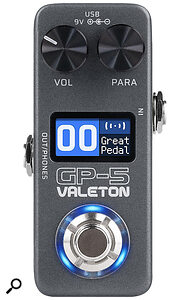 Valeton GP‑5Guitar rig modelling/simulation has come quite a long way since I reviewed the Zoom 503 back in SOS October 1998! Some of the top‑of‑the‑line hardware modellers and profilers currently available are truly amazing, but they also tend to come with a top‑of‑the‑line price tag. IK Multimedia challenged that situation with their ultra‑compact ToneX One (reviewed by Paul White in SOS September 2024) and now Valeton have pushed the bang‑for‑buck ratio even further with the GP‑5. With a full rig, and both modelling and profiling options within a mini‑pedal footprint, at £75, it shouldn’t be able to sound good. But it does. As a compact guitar rig for personal practice, band rehearsals and the occasional gig, Valeton’s GP‑5 is an absolute steal. John Walden
Valeton GP‑5Guitar rig modelling/simulation has come quite a long way since I reviewed the Zoom 503 back in SOS October 1998! Some of the top‑of‑the‑line hardware modellers and profilers currently available are truly amazing, but they also tend to come with a top‑of‑the‑line price tag. IK Multimedia challenged that situation with their ultra‑compact ToneX One (reviewed by Paul White in SOS September 2024) and now Valeton have pushed the bang‑for‑buck ratio even further with the GP‑5. With a full rig, and both modelling and profiling options within a mini‑pedal footprint, at £75, it shouldn’t be able to sound good. But it does. As a compact guitar rig for personal practice, band rehearsals and the occasional gig, Valeton’s GP‑5 is an absolute steal. John Walden





